Visit your favourite destinations |
| A Report from birdtours.co.uk |
Prince Edward Island and the Antarctic pack Ice, 1st 17th November 2002,
Graeme Wallace, Edinburgh, All photos are copyright Graeme Wallace |
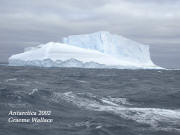 |
Background and summary of the trip
The purpose of the trip, which had never been previously undertaken, was to see as many Southern Ocean seabirds as possible on a route plying from Cape Town through the Indian Ocean, by way of Prince Edward and Marion Islands, to the Antarctic pack ice, returning to Cape Town through the Atlantic Ocean.
The trip was an outstanding success recording 66 bird species and 17 mammals. It was however much more than that; a never to be forgotten odyssey through the spectacular and raging southern oceans, fantastic seascapes, breathtaking icebergs, the desolate beauty and stillness of the pack ice and a pristine environment that man has not yet diminished. From the largest, the soaring Wandering Albatross, to the smallest, the Grey-rumped Storm Petrel, to the world's most southerly breeding bird the exquisite Snow Petrel, the rarely seen Lesser Sheathbill and the daddy of them all the Emperor Penguin, this pioneering pelagic delivered a wonderful range of bird species. |
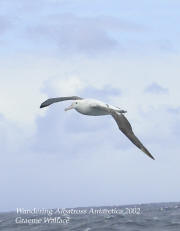 |
As everyone understood, this was never intended to be a luxury cruise as the ship chartered for the voyage was a 20 year old South African supply vessel, the SA Agulhas, which had never previously been used to cater for paying passengers. On this occasion however the ship played host to 80 expectant birders including many of the world list heavy hitters. In the event the ship's company did a great job, using all their seamanship to manoeuvre the vessel as close to the birds as possible and serving good quality meals in some terrible sea conditions. Accommodation on the ship was adequate, food and drink well above expectations and the potential boredom of 17 days at sea relieved by high quality presentations on a variety of wildlife and historical topics and a number of social events.
The trip was originally conceived by Ian Sinclair and was managed and delivered by Birding Africa and Cape Town Pelagics. Both organisations did a great job from handling all the pre trip communications and planning to the daily running of the trip itself. The quality of the trip was underscored by the presence of most of South Africa's leading bird and pelagic guides led by Peter Ryan whose knowledge of all things Antarctic seemed boundless.
The "official record" of the trip by Peter Ryan can be found at www.capetownpelagics.com This trip report sets out personal recollections of the trip based upon my daily diary together with a few photographs that I hope will convey some of the magic of the trip.
Reference Sources
Hadoram Shirihai's guide to Antarctic wildlife provided comprehensive, if somewhat pricey, coverage of all the birds and marine mammals likely to be encountered on the trip. The recently published 3rd edition SASOL Guide to the Birds of Southern Africa covered the majority of the birds.
A great deal of information on seabird conservation,
pelagic birding and whale watching in and around
sa Agulhas Final Track
This line diagram shows the track of the SA Agulhas on its voyage to and from the Antarctic pack ice.
Final Track of the SA Agulhas reproduced here with the kind permission of Cape Town Pelagics.

Daily Account
Ship's position is given as at mid-day.
Friday 1 November 2002 Ships Position 33°55 S 18°27 E Cape Town
Arrived at Berth 500 in Cape Town Harbour with Clide Carter and Chris Lodge with a keen sense of expectation and a degree of foreboding about the 17 day trip bound for Prince Edward and Marion Islands and on to the pack ice of Antarctica passing through some of the roughest oceans in the world (the Roaring Forties and Furious Fifties were to live up to their reputation!). However the potential birdlist, experience of polar seas and pack-ice was more than enough to quell any lingering concern. Once at the quayside the bright red SA Agulhas, a South African research and supply vessel of some 6000 tonnes looked at once both imposing and re-assuring in the dock.
Checked in early, dropped the bags in a small but adequate 4 berth inside cabin and went ashore to pick up some last minute warm clothing. Returned to the ship well in advance of the scheduled 14.00 departure and spent some time becoming familiar with the layout of the ship, its several decks, confusing passageways and hard metallic edges.
Departure delayed while the trip organisers negotiated with immigration officials to allow a British passenger on board who had lost his passport. The passenger was finally denied embarkation, apparently despite assurances from the British Consul. This decision seemed harsh in the extreme given that we would not land anywhere and must have been a hammer blow to the birder.
Finally around 15.00 a tug pulled us from our mooring,
engines growled into life and we headed out of the harbour. No turning back
now! A pod of Dusky Dolphins at the harbour entrance were a great start and
in calm waters we progressed along the coast of
Shortly our first real pelagic species were to appear: Yellow-nosed and Shy Albatross as well as the White-chinned Petrel with which we would become so familiar during the coming days. Finally we passed from dusk into darkness, the beacon from the fabled Cape of Good Hope lighthouse clearly visible on a calm evening. An "icebreaker" followed a surprisingly good dinner offering a chance to meet guides and fellow passengers over a couple of beers on the heli-deck. Shortly after retiring discovered we had one of the world's foremost snorers in our cabin!
Saturday 2 November 2002 Ships Position 36°21 S 21°19 E
| Woke at 03.00 and finally up at 05.30 with the ship's computer indicating a position some 40 miles south of Cape Agulhas. Up on the heli-deck the weather was sunny and calm with something of a swell. A couple of Southern Fulmars were a surprise this far north (still in South African coastal waters); these were followed around 09.00 by the first of several Great Shearwater, a couple of Manx Shearwater, the first Black-browed Albatross, Cape Petrel and Northern Giant Petrel. | 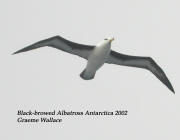 |
Cape Fur Seals were seen and the blow of a distant Hump-backed Whale was a new experience. (Experienced observers can tell the species of whale by its "blow-pattern" and the "footprint" it leaves as it submerges.)
The mid morning lifeboat drill, much advertised in advance, went smoothly but birding soon resumed with Indian and then Atlantic Yellow-nosed Albatross in evidence together with Southern Giant Petrel and, around 13.00, the first Black-bellied Storm Petrels appeared as we dropped off the continental shelf . Early afternoon saw us make a detour for a hake trawler, but this track was altered to allow us to circle a group of albatross resting on the calm water; but the bird that gave rise to most debate was a fly-by of a possible juvenile Salvin's Albatross (split from Shy by some authorities).
It seemed that the drop off the continental shelf into the warm waters of the Agulhas Current had resulted in a noticeable reduction in the number of birds but flying-fish were everywhere and in the late afternoon finally saw the peculiar sunfish. Great-winged Petrel seen in the late afternoon with the day drawing to a close in mist, rain, a noticeably heavy swell and poor views of a Soft-plumaged Petrel.
Sunday 3 November 2002 Ships Position 39°19 S 25°54 E
Slept badly in the pitching boat and on deck at 06.00 to greet an overcast but dry day. Now some 400 miles from Cape Town. By 11.00 a quiet morning had yielded our first Wandering Albatross, a juvenile, followed by Grey Petrel, Southern Giant Petrel and an Antarctic Prion which hung around the stern affording good views. Later in the day the prion numbers built up significantly, mainly Antarctic and possibly Slender-billed Prion but extremely difficult to separate as they skimmed in and around the fleck-capped seas. White-headed Petrels appeared in the late afternoon but deteriorating weather brought the days birding to a close around 17.30. The ship crossed into the roaring forties around 19.00.
Monday 4 November 2002 Ships Position 41°31 S 29°27 E
The roaring forties did not take long to live up to their reputation and awakened at 05.00 by the pitching and rolling of the ship. Outside, the lower deck was awash with water as the seas broke continuously over the sides of the ship. Spent much of the morning on the heli-deck watching the stern of the boat almost disappear beneath the sea as the ship would crest then slide down the back of mountainous swells of water created by the ever increasing storm force winds. The weather continued to deteriorated first to Force 8 deepening to Force 10 touching 11 as the seas grew to 30 - 35 feet swells. One passenger on the poop deck was extremely fortunate not to get washed off the back of the ship along with his camera equipment as a wall of water knocked him flat.
The seascapes however were truly spectacular; the endless grey panorama broken up by massive swells and troughs coloured ice blue and turquoise and capped with white foam as the 50 knot wind whipped across their tops. Against instructions ventured up to the monkey bridge high above the bow to watch the seas breaking over the ship but beat a hasty retreat as flecks of spray at 60 mph feel more like shotgun pellets. Watched the spectacle for a while from the relative safety of the bridge. Birding was almost impossible but persistence rewarded by a Southern Royal Albatross which joined the numerous Wanderers in their effortless and stately flight across the ship's wake. The ship's speed had slowed to just 6 knots.
Tuesday 5 November 2002 Ships Position 43°08 S 33°06 E
Dreadful night with little sleep as the boat pitched and rolled its way through the stormy night. Back on deck at 07.30 the seas were calmer and the storm force wind continued to abate as the day progressed. We were now 8 hours behind schedule and would not arrive at Marion Island until late instead of early Wednesday. We had now crossed the sub-tropical convergence and the temperature was noticeable lower.
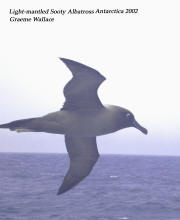 |
Spent virtually the entire day birding from the heli-deck but in a short period below deck managed to miss the only Northern Royal Albatross of the trip. Nevertheless a great days birding revealed 9 species of albatross with Grey-headed and the beautiful Light-mantled Sooty Albatross appearing for the first time. Other new species included Blue Petrel, probable Salvin's Prion and Diving Petrel for some. On the mammal front Sub-Antarctic Fur Seals were seen and those on the monkey bridge also had Hump-backed Whale. |
Wednesday 6 November 2002 Ships Position 46°03 S 36°50 E
After a great nights sleep awoke at 06.00 to a bright, sunny and relatively calm day. A number of Light-mantled Sooty Albatross kept close order with the ship affording fantastic views of their subtle plumage and partial white eye ring that gives them such an "intelligent" or "quizzical" appearance. Finally getting to grips with Salvin's Prion, Soft-plumaged and Blue Petrel but failed miserably all morning to get a good view of the world's smallest pelagic bird, the tiny Grey-rumped Petrel which fluttered in and out of the ships wake.
Late morning ventured forward to the bow where Fairy Prion was being seen and with time the broad black tip to the tail made at least this prion identifiable. Good views were also obtained of diving petrels; tiny little whirring things like miniature brown clockwork puffins, one minute flitting across the waves and gone the next as they dived head first into the swell. They were dwarfed by the seas around them and how they survive is a matter of wonder.
After lunch got on to a tiny grey/brown martin like bird with a paler grey rump - Grey-rumped Storm Petrel at last. The weather deteriorated significantly, overcast with rain and wind rising to Force 9 and by the time we arrived off Marion Island at 17.00 conditions were awful.
As the ship edged into the channel, Marion Island began to emerge from the billowing mist, allowing first sightings of a distant King Penguin colony and closer views of the attractive and endemic Crozet Shag (split from Imperial Shag) as it flew by the boat. Soon after however in deteriorating visibility and a whipping wind the day came to a close. We would spend the night steaming slowly up and down the coast of Marion Island sheltered from the wind between East Cape and Kidalkey. As many birds, particularly prions, are attracted to light cabin curtains over all portholes were covered to prevent the birds, particularly prions, from flying into the ship, injuring or killing themselves.
Thursday 7 November 2002 Ships Position 46°39 S 38°01 E
After a sound but very short night's sleep arose at 02.00 and headed for the heli-deck where spotlighting was scheduled in order to get to grips with the complex identification of prions and diving petrels by examining birds in the hand. How such spotlighting differs from having birds fly into lit portholes I do not know and indeed will never know because the guide elected to lead this turned up 40 minutes late and the half hearted attempt was abandoned shortly thereafter. Went back to bed and got up again at 04.00 in light winds but overcast drizzling rain which meant poor visibility of land as we steamed along the shoreline towards Archway King Penguin colony. However, attention quickly turned from the land to the sea as a large pod of Killer Whales swam close by the ship, clearly visible beneath the clear water, even more so when one surfaced only metres from the boat. Stellar!
Gradually, the light improved and the rain lessened, greatly improving the visibility. Several of the highly restricted Kerguelen Tern were seen feeding offshore in the kelp beds but more importantly the white blobs on land and along the beach gradually resolved into excellent scope views of the scavenging and much wanted endemic Lesser Sheathbill, one of only two species in the family Chionididae. King Penguin could be seen in numbers, sharing the beach with huge Southern Elephant Seals and the marauding Sheathbills; braying Gentoo Penguins along the middle slopes and in between small groups of Rockhopper and Macaroni Penguins proved difficult to separate in the still grey light. Eventually the distinctive red-gape of the Macaroni enabled identification. Both King and Gentoo Penguins could also be seen in the sea close to the ship and the scene was completed by Light-mantled Sooty Albatross on the cliffs and a few Wandering Albatross chicks on the grassy slopes looking very forlorn as they sat out the last days of their ten month lonely fledging vigil before being able to take off to soar the southern oceans.
We had not been granted permission to land on Marion and if the example that followed of landing one researcher was anything to go by its probably just as well that no attempt was made to land and bring back 80 birders. However despite the heavy swell and the zodiac engine cutting out halfway to shore the researcher was landed safely at the base. Zodiacs returned, were hauled up and secured and we began to steam to Prince Edward Island 20km to the north.
Arriving in still murky weather, the uninhabited Prince Edward Island was much more dramatic than its low lying sister Marion with steep rocky escarpments plunging to the sea and deeply etched grassy valleys inland. The captain backed the ship into a bay allowing somewhat closer views of Macaroni and Rockhopper Penguin colonies before steaming around the north of the island, stopping briefly off Albatross Valley, the breeding site of more than 10,000 pairs of albatross, where a few more sitting Wanderer chicks were just visible in the gloomy light.
Chumming at this point proved less successful than hoped for as around 150 Giant Petrels swarmed to the stern to feed greedily, crowding out the other species. Leaving the craggy stacks of Prince Edward Island behind we headed south again to Marion Island slowly passing the King and Macaroni Penguin colony at Kildalkey where around 450,000 breeding pairs are to be found on the hillsides. Close views of five Macaroni Penguins that swam around the ship together with several Sub-Antarctic Fur Seals completed a great days birding around 17.30.
Friday 8 November 2002 Ships Position 48°47 S 34°15 E
The morning air was colder and soon discovered that we had crossed the Antarctic convergence in the night and were now in much colder water about 100 miles south west of Marion Island. The next target was to get to the edge of the pack ice at 54S still some 550 or so nautical miles away. Birds were fewer but included White-headed and Blue Petrels and Salvin's, Antarctic and Fairy Prions but numbers of Kerguelen Petrel proved the main diversion as did possible South Georgian Diving Petrels, although the jury seems to be divided on whether you can identify them from the Common Diving Petrel without first examining their nasal secretions or is it their whiter underwings....?? Mid-afternoon the first iceberg was sighted on the horizon and proved a memorable sight for those like me who had not seen one before but this and the increasingly whipping wind was a mere foretaste of what lay ahead.
Saturday 9 November 2002 Ships Position 50°08 S 30°41 E
A very rough night with little sleep; disturbed particularly around midnight as the ship tried to change course and then had to turn back again. Instead of heading south we had sailed some way west to reduce the rolling and were now headed south west in a described arc which was delaying our progress. Rumours abounded of estimated arrival/non arrival times at the pack ice but the short of it seemed to be that we would reach the northern limits of the ice on Monday night but would have to leave by Tuesday lunchtime. This was bad news indeed and the elation of Marion dissipated into a slough of despond. Brighter news at the evening briefing as the captain explained that the forecast had improved and we should now reach the pack ice by Sunday evening.
Sunday 10 November 2002 Ships Position 53°04 S 26°44 E
Slept in and missed the 06.30 first Antarctic Petrel. On deck, although it was snowing heavily, the seas were much calmer with the ship doing 11 knots, twice the speed of the previous day. Excellent views of Kerguelen Petrel, Slender-billed Prions put on a good show and the only white-phase Southern Giant Petrel of the trip joined us for a while. The snow gradually subsided and shortly before lunch a second Antarctic Petrel appeared giving good looks for all - a handsome bird indeed.
| As we progressed southward it grew chillier by the hour and suddenly we were joined by the first Snow Petrels; four birds which fluttered round the ship for some time before flying off. This was one of the great highlights of my trip partly because they are stunning little white birds with coal black eyes and bill but mainly because as they breed on continental Antarctic I was seeing the world's most southerly breeding bird. | 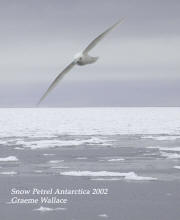 |
Icebergs began to appear off the bow of the ship in late afternoon and the captain changed course heading for one 19 miles away. As we sailed towards the iceberg it became apparent that it was of titanic proportions and as we drew closer its mass totally dominated the ship. It was a truly breathtaking sight of pure white crystalline ice with a cracked and broken pattern caused by horizontal fractures of pale blue ice and even deeper vertical fissures of deep blue. As the viscous blue sea broke and retreated over the base of the berg every colour of blue and grey seemed to be revealed.
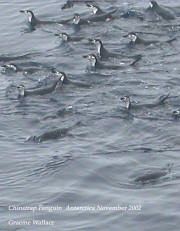 |
By now we had been joined by many Cape, Blue, Snow and Antarctic Petrels flying all around together with Chinstrap Penguins in the water. The berg itself proved to be home to some 1600 Chinstraps clinging to its icy lower slopes. Later that evening as the sun was setting we finally entered the pack ice but turning for one final look before dusk revealed the last rays of the sun casting a faint rosy pink glow on the top corner of the iceberg before it was quickly extinguished and replaced by a deep purple sky. It was truly a magical few hours that will live in the memory for a very long time. |
Monday 11 November 2002 Ships Position 53°07 S 22°58 E
Armistice Day brought a pre-dawn start at 03.00 which was far too early as it was still dark but well worth it as Peter Ryan notes in his report " to find the ship steaming through bands of drift ice interspersed by smoky patches of semi-frozen, glassy sea and a glimmer of golden dawn on the south-west horizon" The ship sailed quietly through the still air, the silence broken only by the sound of cracking pack ice as we passed through. It was a beautiful sight.
As the sun rose higher everyone began to look eagerly for the remaining pack ice specialists, Adelie and Emperor penguins, or XXL as the latter had become colloquially known. Emperor Penguins breed much further south on the highly inaccessible Antarctic continent but our guides were guessing that some might be found at the edge of the pack ice. No one had been down here this time of year, so no-one really knew what to expect and the air crackled with expectation. At the bow there were a number of false alarms but an Antarctic Minke Whale cruising slowly past the bow just beneath the crystal clear water was a great sight.
As we progressed through the ice some of the floes would flip over as the boat nudged them revealing the yellow and green stained underside of algal growth that provides a food source for the swarming Antarctic krill that in turn supports the food chain for many Antarctic creatures. After 4 hours on deck and despite heading through thickening ice neither Penguin had been sighted, time was running short as we had to leave the ice that afternoon and it was a quiet company that trooped off for breakfast.
The quiet was shattered midway through breakfast as Ian Sinclair appeared at the dining saloon door yelling "Emperor !!" I thought I was quick off the mark but at least 30 others were before me as we raced upstairs and out on to the deck; too late however to see the penguin which had apparently dived off its icy perch. Scanned the ice for a while before returning in somewhat dejected fashion to the saloon to congealed fried eggs. The nightmare scenario was now upon us where some had seen the Emperor but many had not and this might be the only bird. Such thoughts were banished almost immediately however when there was a second cry of Emperor! Racing upstairs and then to the bow we saw the unmistakable bulky figure of an Emperor Penguin swimming just off the bow. It was an immature bird which swam around for 10 minutes, diving occasionally before diving and disappearing for the last time. However the key bird of the trip had been well seen leaving only one last penguin species - the Adelie.
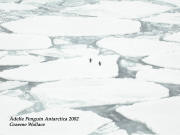 |
Shortly after lunch up on the monkey bridge I watched as Peter Ryan sighted 2 penguins on an ice floe at least 800 metres away and radioed the bridge to say that he thought he had 2 Adelie Penguins. The captain changed course and slowly inched the 6000ton ship through the ice until scope views showed clearly these were indeed two Adelie Penguin - the last penguin of the trip. As we inched ever closer and circled around them the penguins looked bemused, not sure what to do and I did wonder what they made of the great red ship towering above. I also marvelled at the skill of the guide to call the bird so far away and of the ship's crew for getting us so close. |
Crabeater Seals were seen and later, as a wide mouthed reptilian Leopard Seal was sighted lounging on an ice floe, the snow began to fall in earnest blanketing the sky and covering the ship. To their eternal credit the crew prepared a memorable braii on the heli-deck in the middle of the snowstorm in sub zero temperatures and a great party ensued. Before retiring I did however take 5 minutes towards the bow of the ship away from the party to enjoy the solitude, to look over the frozen waste and reflect upon how fortunate we had been to enjoy such an environment and its wildlife.
Tuesday 12 November 2002 Ships Position 52°49 S 21°25 E
| Slept well, earplugs helping to screen out the worst of the snoring of one of my cabin companions, and was back on deck at 07.00 to heavy seas and a howling wind. Although still in Antarctica, the ice and Snow Petrels were gone but it had been magical while it lasted. Strap-toothed Whale off the bow provided reward for early risers but as the day wore on the wind increased again to Force 9 and many spent the day relaxing, chatting and catching up on diaries so little to report on the birding front except the now familiar Kerguelen, Blue and Cape Petrels and the odd Wandering Albatross. As the day progressed the weather became foul with Force 11 winds gusting 12, waves crashed over the heli-deck and to keep us upright the captain had to turn the ship directly into the westerly wind rather than follow the northerly course that would take us to Cape Town. |  |
Wednesday 13 November 2002 Ships Position 51°28 S 19°01 E
A dreadful night of little sleep, the ship pitching violently as the captain tried to veer north but was forced back on to the westerly course to avoid the ship rolling over. Despite steaming all night, by morning we were actually further south than when we began. A rough morning followed enlivened by all the plates and crockery being thrown off the dining tables before the ship turned north east, back on track for Cape Town taking advantage of the SE wind. Few birds seen.
Thursday 14 November 2002 Ships Position 46°57 S 17°31 E
A much better night passed into a clear mild morning with the ship still making good speed. 4 species of albatross before breakfast with particularly good views throughout the day of Black-browed and Light-mantled Sooty Albatross. Later a Northern Royal Albatross that did not look quite right was confirmed as Northern by two of the guides (meaning that I had finally caught up on this tricky species) only to have them subsequently change their minds (following much debate) to immature Southern, a fact subsequently confirmed by the wonders of digital photography which showed the bird to have a black cutting edge diagnostic of this species. Hmm?? The Jock's Lodge team of the Buck Boys, Hornbuckle and Wallace came a creditable 3rd in the quiz that night.
Friday 15 November 2002 Ships Position 42°43 S 17°38 E
Another wild night tossed us around our bunks and slowed
progress still further. Estimated arrival in Cape Town had now gone back to
the morning of Monday 18th causing consternation and a frenzy of
flight rebooking by those bold enough to have booked a Sunday night flight.
As I was staying in
Saturday 16 November 2002 Ships Position 39°25 S 15°56 E
The weather had not yet relented but, after another rolling night, the morning found us in calmer waters, the day warming up considerably as we headed home. Several Atlantic Petrels were the highlight and the day culminated in an excellent Landfall Dinner immaculately prepared by the galley staff who, it should be recorded, had provided us with 3 good meals a day even in the most appalling of conditions. The consumption of large amounts of wine at dinner was exceeded only by the consumption after dinner in excellent and buoyant company. Very late to bed but not sure at what time.
Sunday 17 November 2002 Ships Position 34°56 S 18°03 E
A late start, barely in time for breakfast, saw calm
seas and sunny skies with about 150 miles to Cape Town. Numbers of Great-winged
Petrels drifted and as the morning progressed several individual and a small
groups of Leach's Petrels were seen. After lunch on deck we passed through the
fishing grounds off
Sunday 17 November 2002 Ships Position 33°51 S 18°20 E Cape Town
18.00 docked at Cape Town with Speckled Pigeon on the guard rail the final bird of the trip. It had been quite a journey.
Bird Species List.
King Penguin (Aptenodytes patagonicus)
Seen in small groups of 100-200 birds on the beach and around Marion Is. early on7/11 and later that day seen from a distance in hundreds of thousands at Kildalkey, also on Marion Is.Emperor Penguin (Aptenodytes forsteri)
One immature bird seen in the pack ice at latitude 55S. on 11/11. Nevertheless a remarkable find.Gentoo Penguin (Pygoscellus papua)
A few birds in the water as we arrived off Marion Is. on 7/11 with small groups of c 50 birds along the lower slopes the following morning.Adelie Penguin (Pygoscellus adeliae)
Scope views of 2 birds seen in the pack ice on11/11.Chinstrap Penguin (Pygoscellus antarctica)
Surprisingly large numbers of birds in the pack ice each day from 10-12/11 with 1600 on the iceberg on10/11.Rockhopper Penguin (Eudyptes chrysocome)
Seen in their hundreds at their colonies in Marion and Prince Edward Is on7/11.Macaroni Penguin (Eudyptes chrysolophus)
Seen in their hundreds at their colonies in Marion and Prince Edward Is on7/11 an later the same day seen from a distance in hundreds of thousands at Kildalkey.African Penguin (Spheniscus demersus)
Seen in small numbers in South African coastal waters on the first and last days of the tripWandering Albatross (Diomedea exulans)
After leaving SA coastal waters on 2/11 this inveterate ship follower seen daily thereafter in good numbers except while in the pack ice.Northern Royal Albatross (Diomedea sanfordi)
Throughout the trip I cursed missing this bird while below deck on 5/11. However the "official trip report" on Cape Town Pelagics website does not list this bird as being seen on 5/11 nor any other day for that matter with only a couple of "possible sightings" apparently on 8&9/11. Either way I never saw it.Southern Royal Albatross (Diomedea exulans)
Mainly single birds only seen away from coastal waters over the ocean except and not in the pack ice.Shy Albatross (Thalassarche cauta)
See daily during the first five days of the trip and then in good numbers on the final day.Salvin's Albatross (Thalassarche salvini)
One possible juvenile bird seen on2/11but not positively identified.Black-browed Albatross (Thalassarche melanophris)
Seen regularly throughout the trip except while in the pack ice.Grey-headed Albatross (Thalassarche chlororhynchos)
Seen daily sometimes in good numbers in oceanic waters outside of the pack ice.Indian Yellow-nosed Albatross (Thalassarche carteri)
Seen daily in good numbers throughout the Indian Ocean sector to Marion Is. but not thereafter.Atlantic Yellow-nosed Albatross (Thalassarche chlororhynchos)
Seen in low numbers on the sector down to Marion Is. and again on the last 3 days.Southern Giant Petrel (Macronectes giganteus)
Common throughout.Northern Giant Petrel (Macronectes halli)
Common throughout.Light-mantled Sooty Albatross (Phoebetria palpebrata)
Possibly the bird of the trip this beautiful albatross had a more southerly distribution than its Dark cousin with particularly great views as several birds kept close order with the ship on 14/11.Dark-mantled Sooty Albatross (Phoebetria fusca)
Seen daily away from coastal waters and outside the pack ice with up to ten birds in a day.White-chinned Petrel (Procellaria aequinoctialis)
One on the commonest petrels.Sooty Shearwater (Puffinus griseus)
Not uncommon in the more northerly and coastal waters.Great-winged Petrel ( Pterodroma macroptera)
Seen almost daily in the waters north of 56S.Kerguelen Petrel (Aphodroma brevirostris)
Seen regularly in the waters south of Marion even down to the edge of the pack ice.Grey-Petrel ( Procellaria cinerea)
Seen irregularly in very small numbers away from coastal waters and outside the pack ice.Great Shearwater ( Puffinus gravis)
Seen only on 4 days either in or on the edge of SA coastal waters.Corys Shearwater (Calonaectris diomedia)
15-20 birds seen on the final day.Manx Shearwater ( Puffinus puffinus)
Only 2 birds on 2/11.Little Shearwater (Puffinus assimilis)
Seen regularly in small numbers on the Indian Ocean sector down to Marion Is.Antarctic Fulmar (Fulmarus glacialoides)
Seen almost daily outside coastal waters except for a surprise pair on the second day.Antarctic Petrel (Thalassoicia antarctica)
Only on 2 days in and around the pack ice where seen in surprisingly good numbers.Pintado Petrel (Daption capense)
Common throughout.Atlantic Petrel ( Pterodroma incerta)
Uncommon with only a few birds seen on 16/11.White-headed Petrel ( Pterodroma lessonii)
Seen regularly outside coastal waters and the pack ice.Soft-plumaged Petrel ( Pterodroma mollis)
Seen almost daily except in the pack ice, sometimes in good numbers.Antarctic Prion ( Pachyptila desolata)
A few birds seen early in the trip on the leg don to Marion Is. but many more seen south of Marion, in the pack ice and on the Atlantic sector with the last seen on 16/11.Blue Petrel ( Halobaena cearulea)
Common from Marion Is. south into the pack ice and in the Atlantic - last seen 15/11Salvin's Prion ( Pachyptila salvini)
Seen in large numbers in the Indian Ocean to the start of the South Polar Sea.Slender-billed Prion ( Pachyptila belcheri)
Uncommon and only seen in very small numbers on 10 &13/11.Fairy Prion ( Pachyptila turtur)
Only seen in any numbers in and around Marion Is.Leach's Storm Petrel (Oceanodroma leucorhoa)
Only seen on the final day when a few singles and the odd small group seen off the coast of SA.Black-bellied Storm Petrel (Fregatta tropica)
Common throughout the trip except in coastal waters and the pack ice.Common Diving-Petrel (Pelecanoides urinatrix)
A few birds seen north of Marion Is. on 5/11 with more around the approaches to Marion on 6/11.South Georgian Diving-Petrel (Pelecanoides georgicus)
Possibly also seen around Marion Is. and more probably south of Marion Is. on 8/11.Cape Gannet (Moris capensis)
Common around the coastal waters off SA.Bank Cormorant (Phalacrocorax neglectus)
A very few birds seen on the final run in to Cape Town on 17/11.Cape Cormorant ( Phalacrocorax capensis)
Good numbers seen in coastal waters on the first and last days of the trip.Crozet Shag (Phalacrocorax )
This handsome endemic seen in small numbers only around Marion Is. on 5&6/11Red Phalarope (Phalaropus fulicaria)
A flock presumed to be this species flew past on the final run in to Cape Town on 17/11.Sub-Antarctic Skua (Catharacta antarctica)
Seen daily on the Indian Ocean leg as far south as Marion Is. but never thereafterPomarine Skua (Stercorarius pomarinus)
One or 2 birds on 2/11.Long-tailed Skua (Stercorarius longicaudus)
A few birds seen during the last 3 days of the trip.Kelp Gull (Larus dominicanus)
A few birds off the coast of SA and at Marion Is.Sabine's Gull (Larus sabini)
A few birds seen on 01&02/11 but hundreds on the final run in to Cape Town on 17/11.Hartlaub's Gull (Larus hartlaubii)
A few seen as we departed Cape Town on01/11.Swift Tern (Sterna bergii)
Small numbers in coastal waters off SA on the first and last day of the voyage.Sandwich Tern (Sterna sandvicensis)
Small numbers seen on the final run in to Cape Town ob 17/11.Common Tern (Sterna hirundo)
Apparently seen as we left Cape Town Harbour.Arctic Tern (Sterna paradisaea)
See regularly throughout the tripAntarctic Tern (Sterna vittata)
A very few birds seen off Marion Is .on 6/11Kerguelen Tern (Sterna virgata)
Small numbers seen feeding in the kelp beds off Marion Is.on6/11.
Mammal species list
This list represents all the mammals seen on the trip. Only those with asterisks were seen by me and if there was any disappointment on the trip it was perhaps the lack of good views of cetaceans - perhaps the wild weather was a factor??
Cape Fur Seal*
Sub-Antarctic Fur Seal*
Antarctic Fur Seal*
Southern Elephant Seal*
Leopard Seal*
Antarctic Minke Whale*
Dwarf Minke Whale
Fin Whale
Humpback Whale*
Risso's Dolphin
Dusky Dolphin*
Common Dolphin*
Killer Whale*
Sperm Whale
Southern Bottle-nosed Whale
Strap-toothed Beaked Whale
Why not send us a report, or an update to one of your current reports?